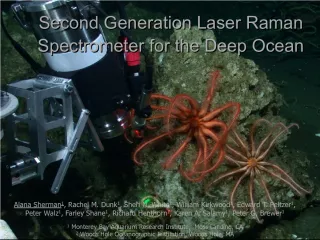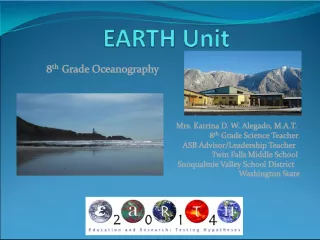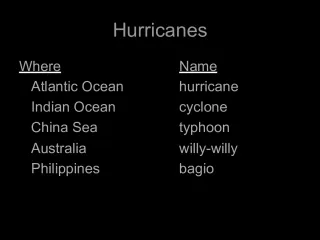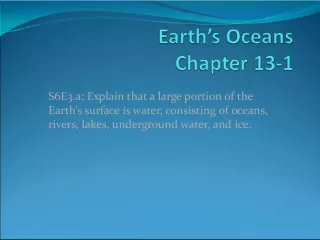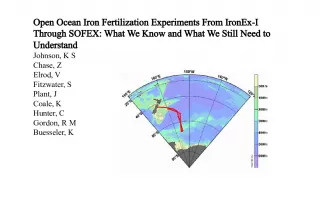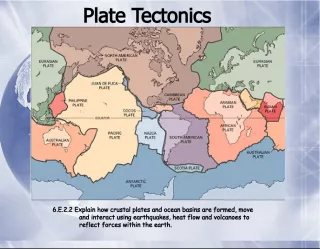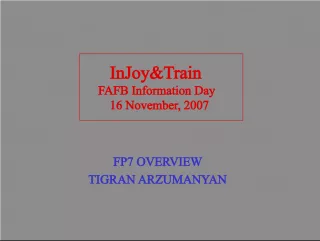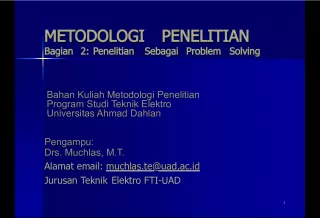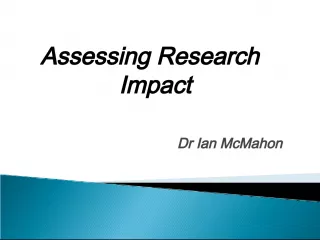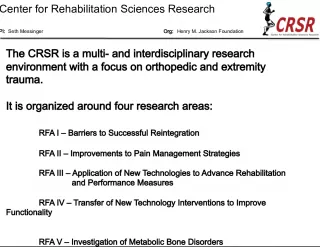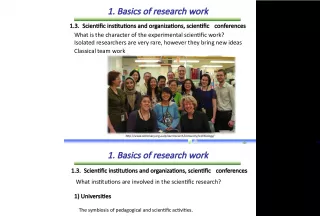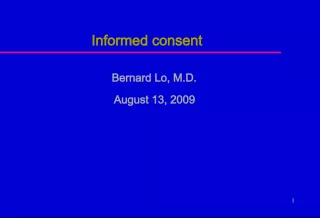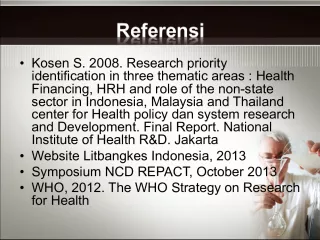Ocean Acidification Impacts and Research in Alaska
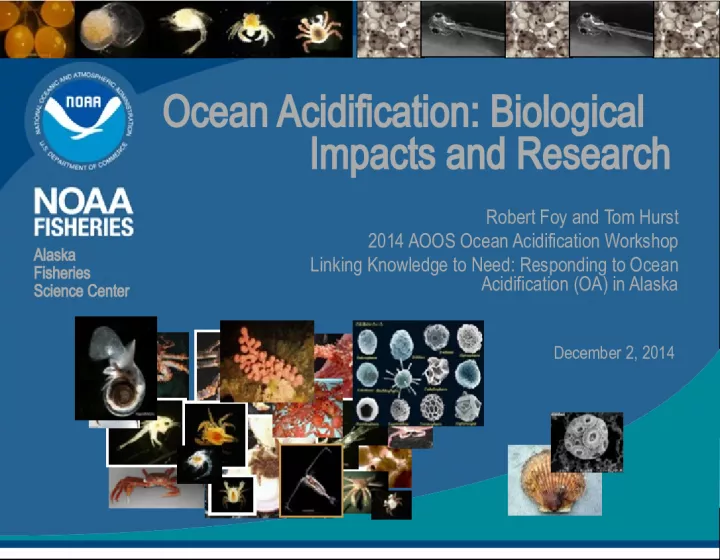

Learn about the effects of ocean acidification on Alaska's marine ecosystem, including commercially important fish and shellfish species, and the research being conducted to forecast population impacts and economic consequences.
- Uploaded on | 0 Views
-
 jacks
jacks
About Ocean Acidification Impacts and Research in Alaska
PowerPoint presentation about 'Ocean Acidification Impacts and Research in Alaska'. This presentation describes the topic on Learn about the effects of ocean acidification on Alaska's marine ecosystem, including commercially important fish and shellfish species, and the research being conducted to forecast population impacts and economic consequences.. The key topics included in this slideshow are ocean acidification, Alaska, commercial fisheries, species-specific responses, monitoring,. Download this presentation absolutely free.
Presentation Transcript
1. Ocean Acidification: Biological Impacts and Research Robert Foy and Tom Hurst 2014 AOOS Ocean Acidification Workshop Linking Knowledge to Need: Responding to Ocean Acidification (OA) in Alaska Alaska Fisheries Science Center December 2, 2014
2. NOAA Alaska Fisheries Science Center Research Approach Focal species groups Commercially important fish and shellfish species; Their prey (calcareous plankton); And shelter (corals). Objectives Ocean pH monitoring Understand species-specific physiological responses; Forecast population impacts and economic consequences.
3. King and Tanner Crab Research 2006-2007 pilot experiments: effects of pH change on growth and survival of blue king crab. 2008 AFSC ocean acidification research plan 2008-2009 methods development: water chemistry and mineral measurement method development effective CO 2 delivery system designed for red king crab Additional response variables 2010-2013 experimentation: Red king crab larval growth and survival response to increased pCO 2 Golden king crab adult physiological response to increased pCO 2 Tanner crab larval and adult response to increased pCO 2 W. Christopher Long, Katherine M. Swiney, and Robert J. Foy Long, Swiney, Foy. 2013. Effects of Ocean acidification on embryos and larvae of red king crab, Paralithodes camtschaticus . Marine Pollution Bulletin. 69: 38-47 . Long, Swiney, Harris, Page, Foy. 2013. Effects of ocean acidification on juvenile red king crab ( Paralithodes camtschaticus ) and Tanner crab ( Chionoecetes bairdi ). PLoS ONE 8(4).
4. red king crab ( Paralithodes camtschaticus) blue king crab ( Paralithodes platypus) golden king crab ( Lithodes aequispinus ) King and Tanner Crab Research Important shell (cuticle) components are chitin, calcium carbonate and protein Calcium carbonate occurs mainly as calcite although the amorphous form sometimes occurs Why Crab??
5. Depth distributions As depth increases: (pressure increases, temperature decreases, and pH decreases) all of which promote the dissolution of CaCO3. Affected by pH? Affected by CaCO 3 saturation state? King and Tanner Crab Research
6. Experiments: Red king crab ( Paralithodes camtschaticus ) adult females Red king crab embryos and larvae Red king crab juveniles Tanner crab ( Chionoecetes bairdi ) juveniles Golden king crab ( Lithodes aequispinus ) adults Response variables : Survival, fecundity, morphometrics (image analysis), growth (width and wet mass), calcification Treatment system: Flow through CO 2 delivery system pH control Daily pH, temperature, and salinity measurement Weekly water samples taken for DIC and Alkalinity King and Tanner Crab Research
7. Kodiak Fisheries Research Center Seawater Facility OA Treatment system: Open, flow through CO 2 delivery system 2 L/min 10 L/min Current capability: 1 control, 4 CO 2 treatments In construction: 2 controls, 8 CO 2 treatments, 3 temperature treatments, variable control pH control Daily pH, temperature, and salinity measurement Weekly water samples taken for DIC and Alkalinity
8. Red King Crab Embryos Adult females collected from Bristol Bay fishery pHs: Ambient and 7.7 (~2100) Decreased pH associated with smaller eggs and embryos and larger yolks.
9. Larvae collected as they hatched Starvation survival experiments fully crossed with mom treatments 5 replicates with 20 larvae pHs: ambient and 7.7 Calcification increased Morphometrics varied Survival decreased Red King Crab Larvae control mom and control larvae acidified mom and acidified larvae
10. Crabs held in individual containers Control, pH 7.8, pH 7.5 30 crabs/treatment Check for molts/mortalities Measure pH/temp Growth (length and mass) reduced Calcium content did not change Red King Crab Juveniles Tradeoff?
11. Crabs held in individual containers Control, pH 7.8, pH 7.5 30 crabs/treatment Survival decreased with decreasing pH Red King Crab Juveniles
12. Bristol Bay red king crab fishery: OA scenarios based on trends in recruitment Forecasts based on bioeconomic model linked to a population dynamics model King Crab Population Effects UAF USCG Michael Dalton, Andre Punt
13. stock dynamics without OA King Crab Population Effects: Red King Crab At a pH of 7.8 stocks and catches decline Under current catch levels fishery would be closed in about 2100 Punt, Poljak, Dalton, Foy. 2014. Evaluating the impact of ocean acidification on fishery yields and profits: The example of red king crab in Bristol Bay. Ecological Modeling. 285: 39-53 . stock dynamics with OA
14. Ocean Acidification outreach Ocean Acidification outreach Ocean Science Discovery Lab Kodiak Fisheries Research Center Ocean Science Discovery Lab NMFS and Kodiak Island Borough School District collaboration Ocean Science Literacy Goal: to improve Ocean Science Literacy in grades K -12 Middle School: What is OA? How do you measure ocean pH? Intro to pH scale and ocean chemistry Algal growth and plankton exposure experiments High School: HS Oceanography class Local OA background Global OA implications Climate change
15. Thank you. Questions? WWW.AFSC.NOAA.GOV Alaska Fisheries Science Center Research Staff

